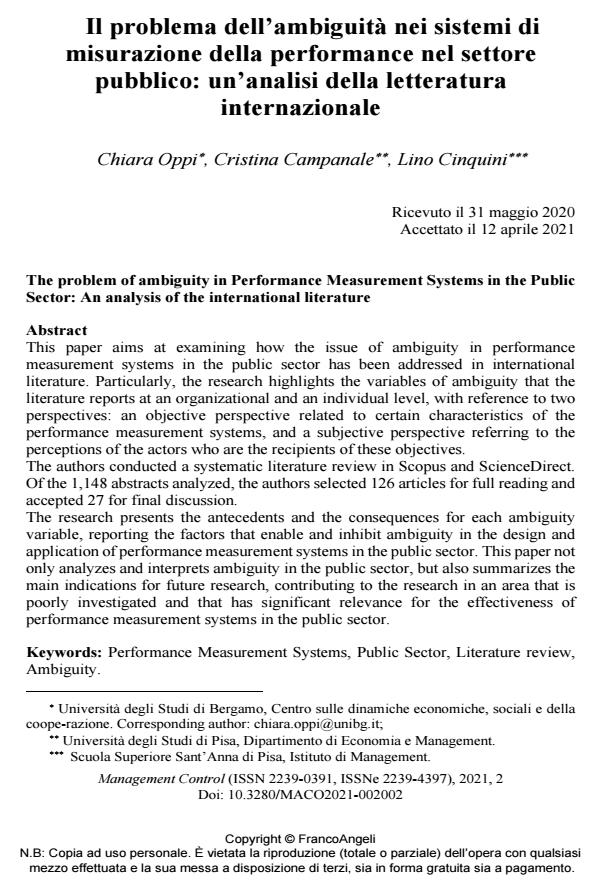The problem of ambiguity in Performance Measurement Systems in the Public Sector: An analysis of the international literature
Journal title MANAGEMENT CONTROL
Author/s Chiara Oppi, Cristina Campanale, Lino Cinquini
Publishing Year 2021 Issue 2021/2
Language Italian Pages 28 P. 11-38 File size 278 KB
DOI 10.3280/MACO2021-002002
DOI is like a bar code for intellectual property: to have more infomation
click here
Below, you can see the article first page
If you want to buy this article in PDF format, you can do it, following the instructions to buy download credits

FrancoAngeli is member of Publishers International Linking Association, Inc (PILA), a not-for-profit association which run the CrossRef service enabling links to and from online scholarly content.
This paper aims at examining how the issue of ambiguity in performance measurement systems in the public sector has been addressed in international literature. Particularly, the research highlights the variables of ambiguity that the literature reports at an organizational and an individual level, with reference to two perspectives: an objective perspective related to certain characteristics of the performance measurement systems, and a subjective perspective referring to the perceptions of the actors who are the recipients of these objectives. The authors conducted a systematic literature review in Scopus and ScienceDirect. Of the 1,148 abstracts analyzed, the authors selected 126 articles for full reading and accepted 27 for final discussion. The research presents the antecedents and the consequences for each ambiguity variable, reporting the factors that enable and inhibit ambiguity in the design and application of performance measurement systems in the public sector. This paper not only analyzes and interprets ambiguity in the public sector, but also summarizes the main indications for future research, contributing to the research in an area that is poorly investigated and that has significant relevance for the effectiveness of performance measurement systems in the public sector.
Keywords: Performance Measurement Systems, Public Sector, Literature review, Ambiguity.
- Towards Digital and Sustainable Organisations Manuela Paolini, Domenico Raucci, pp.69 (ISBN:978-3-031-52879-8)
Chiara Oppi, Cristina Campanale, Lino Cinquini, Il problema dell’ambiguità nei sistemi di misurazione della performance nel settore pubblico: un’analisi della letteratura internazionale in "MANAGEMENT CONTROL" 2/2021, pp 11-38, DOI: 10.3280/MACO2021-002002